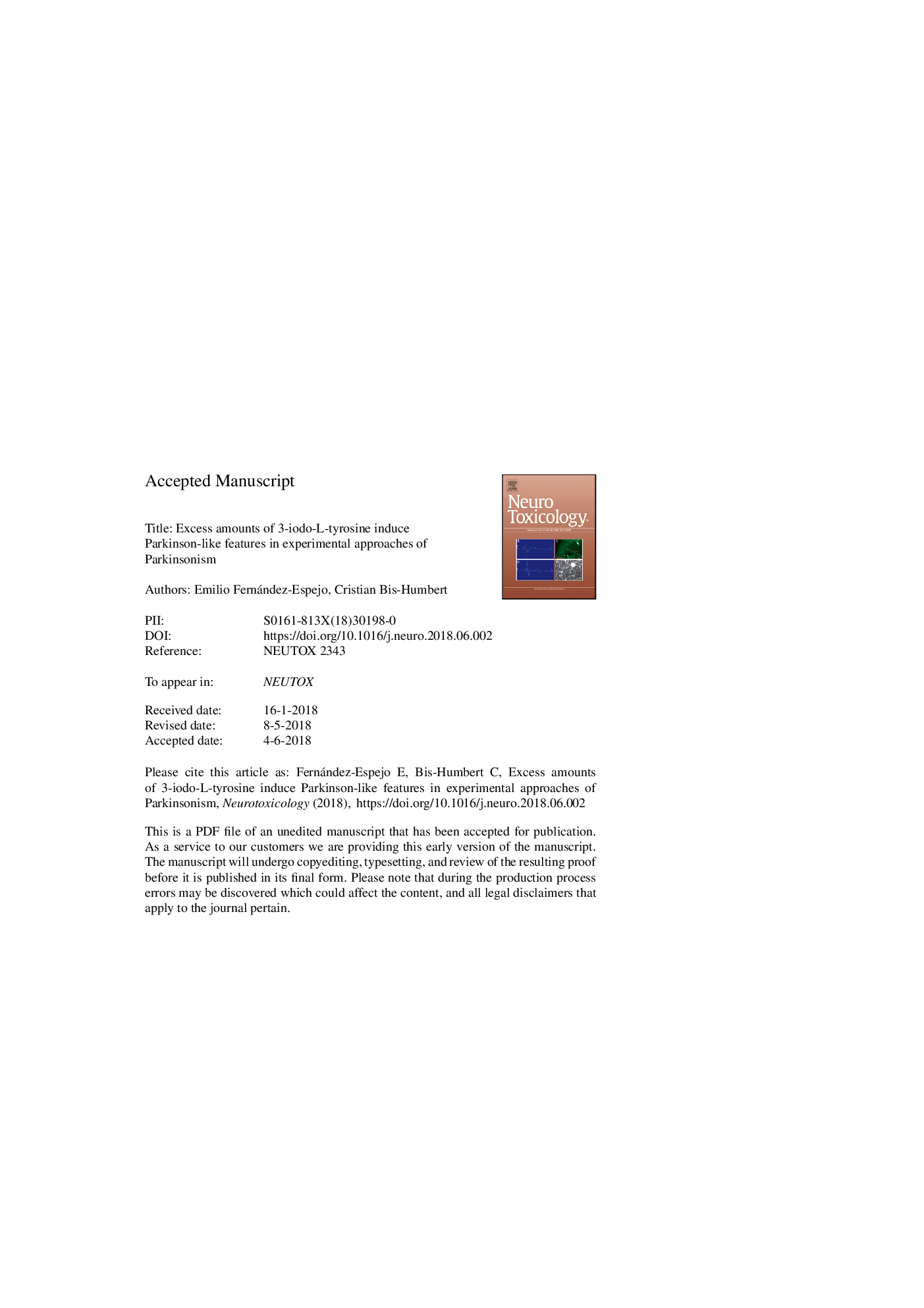| کد مقاله | کد نشریه | سال انتشار | مقاله انگلیسی | نسخه تمام متن |
|---|---|---|---|---|
| 8550117 | 1562027 | 2018 | 45 صفحه PDF | دانلود رایگان |
عنوان انگلیسی مقاله ISI
Excess amounts of 3-iodo-l-tyrosine induce Parkinson-like features in experimental approaches of Parkinsonism
ترجمه فارسی عنوان
مقدار بیش از حد 3-یدو ال-تیروزین باعث تشخیص پارکینسون در روش های تجربی پارکینسونی می شود
دانلود مقاله + سفارش ترجمه
دانلود مقاله ISI انگلیسی
رایگان برای ایرانیان
کلمات کلیدی
موضوعات مرتبط
علوم زیستی و بیوفناوری
علوم محیط زیست
بهداشت، سم شناسی و جهش زایی
چکیده انگلیسی
3-iodo-l-tyrosine might play a role in Parkinson's disease since this molecule is able, at high concentration, to inhibit tyrosine-hydroxylase activity, the rate-limiting enzyme in dopamine biosynthesis. The possible Parkinson-like effects of 3-iodo-l-tyrosine were tested on three experimental approaches in mice: cultured substantia nigra neurons, the enteric nervous system of the jejunum after intra-peritoneal infusions, and the nigrostriatal system following unilateral intrabrain injections. 3-iodo-l-tyrosine, a physiological molecule, was used at concentrations higher than its serum levels in humans. Parkinson-like signs were evaluated through abnormal aggregation of α-synuclein and tyrosine-hydroxylase, loss of tyrosine-hydroxylase-expressing and striatum-projecting neurons and fibers, reduced tyrosine-hydroxylase density, and Parkinson-like motor and non-motor deficits. The retrograde tracer FluoroGold was used in the brain model. The findings revealed that excess amounts of 3-iodo-l-tyrosine induce Parkinson-like effects in the three experimental approaches. Thus, culture neurons of substantia nigra show, after 3-iodo-l-tyrosine exposure, intracytoplasmic inclusions that express α-synuclein and tyrosine-hydroxylase. Intra-peritoneal infusions of 3-iodo-l-tyrosine cause, in the long-term, α-synuclein aggregation, thicker α-synuclein-positive fibers, and loss of tyrosine-hydroxylase-positive cells and fibers in intramural plexuses and ganglia of the jejunum. Infusion of 3-iodo-l-tyrosine into the left dorsal striata of mice damages the nigrostriatal system, as revealed through lower striatal tyrosine-hydroxylase density, reduced number of tyrosine-hydroxylase-expressing and striatum-projecting neurons in the left substantia nigra, as well as the emergence of Parkinson-like behavioral deficits such as akinesia, bradykinesia, motor disbalance, and locomotion directional bias. In conclusion, excess amounts of 3-iodo-l-tyrosine induce Parkinson-like features in cellular, enteric and brain approaches of Parkinsonism in mice.
ناشر
Database: Elsevier - ScienceDirect (ساینس دایرکت)
Journal: NeuroToxicology - Volume 67, July 2018, Pages 178-189
Journal: NeuroToxicology - Volume 67, July 2018, Pages 178-189
نویسندگان
Emilio Fernández-Espejo, Cristian Bis-Humbert,
